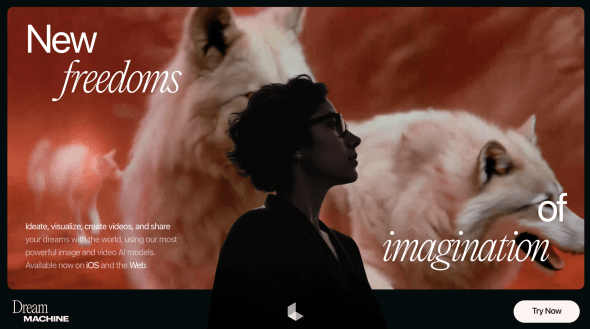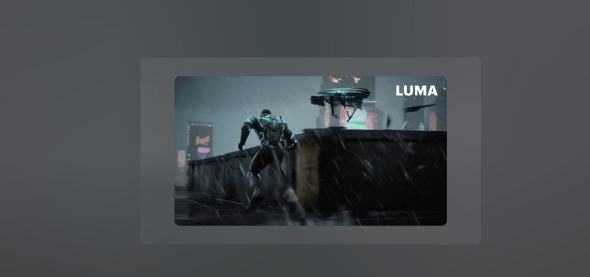Luma AI: A Deep Dive into the Ray3 Model’s Reasoning and HDR Features
Luma AI Dream Machine is a generative AI model that creates high-quality, realistic videos from text and image prompts. Developed by San Francisco-based Luma Labs, the tool launched to the public on June 12, 2024. Luma AI’s video generator is designed for a broad audience, including creative professionals, filmmakers, artists, and marketers, aiming to democratize video creation. It is particularly useful for those who need to produce high-quality video content without the associated high costs and long production times.
The platform’s main function is its ability to quickly translate ideas into fluid, coherent video clips with noteworthy camera motion. With Ray3, this has expanded beyond simple generation. The model now incorporates a reasoning system that can plan scenes, evaluate its own work, and follow complex instructions. This technology presents a direct alternative to traditional methods of video production and storyboarding. By offering an accessible yet powerful tool, Luma AI allows users to visualize concepts, create short-form content, and iterate on creative directions with greater speed and precision than before.
Best Use Cases for Luma AI
- Social Media Managers and Content Creators: For professionals managing a constant content pipeline, the tool solves the need for fresh, engaging video. It can generate eye-catching clips for platforms like TikTok and Instagram, animate static images or memes for higher engagement, and quickly produce A/B test variations for ad creatives. This drastically reduces reliance on stock footage or complex animation software.
- Filmmakers and Animators: This AI video generator serves as a useful pre-visualization and storyboarding tool. It allows directors and animators to quickly mock up scenes, experiment with camera movements, and establish a visual tone before committing to production. For example, a filmmaker can generate a dozen different camera angles for a key scene in minutes, helping to refine their creative vision efficiently.
- Marketing Professionals: Marketers can leverage Luma AI to create compelling video content for digital ad campaigns and product showcases. The tool allows for the rapid creation of short promotional videos that highlight product features or evoke a specific brand feeling. This accelerates the creative process, enabling marketing teams to be more agile and responsive to market trends.
- Artists and Designers: Digital artists can use Luma AI to bring their static creations to life. By feeding an image into the model, they can generate short animations, adding motion and narrative to their work. This opens up new avenues for digital art and allows for the creation of unique, dynamic pieces for online portfolios or digital exhibitions.
- Game Developers and VFX Artists: The ability to generate realistic physics and coherent motion makes Ray3 a useful tool for creating environmental animations, character action prototypes, and background plates for visual effects work.
Professional-Grade HDR Output: Ray3 is the first generative model to produce video in true HDR, supporting professional color standards for cinematic quality.
Rapid Prototyping with Draft Mode: Test ideas up to 10x faster, allowing for extensive creative exploration before committing to a final, high-quality render.
Advanced Reasoning and Control: The new multimodal reasoning system follows complex instructions and maintains character and scene consistency with greater accuracy.
High-Quality Motion and Realism: The model produces videos with excellent visual quality and logical consistency.
Native 1080p and 4K Upscaling: Delivers crisp 1080p video directly and offers a neural upscaler for clean 4K output suitable for professional use.
Strong Industry Integration: The partnership with Adobe Firefly connects the tool directly to professional creative workflows.
Short 5-Second Video Length: While clips can be extended, the base 5-second length remains a primary operational detail for creating longer narratives.
Learning Curve for Advanced Features: While the basic interface is simple, getting the most out of the reasoning system and precise controls requires practice.
High Demand on Resources: High-quality renders, especially at 4K, can still require significant processing time and credits.
-
Multimodal Reasoning System (Ray3): An intelligent core that plans scenes, understands complex prompts (including image annotations), and refines its output for better coherence.
-
Native HDR Generation (Ray3): The first generative model to output video in professional 10-, 12-, and 16-bit ACES color standards.
-
Draft Mode (Ray3): A rapid-generation mode for quick iteration, with the ability to “master” a chosen draft to full quality.
-
Native 1080p and 4K Neural Upscaler (Ray3): Produces sharp 1080p video and can upscale to 4K without common motion artifacts.
-
Text-to-Video AI Generation: The core function that transforms written descriptions into 5-second video clips.
-
Image-to-Video Generation: Animates still images, bringing them to life with generated motion.
-
Video Extension: An option to continue a previously generated clip, allowing for slightly longer and more developed scenes.
-
In-Video Editing: Users can modify existing generations by describing the desired changes in a text prompt.
-
Camera Motion Control: Provides specific commands to control camera movements, such as panning, tilting, and zooming, for more dynamic shots.
-
Consistent Characters: Maintains the appearance of a specific character across different generated videos from a single source image.
-
Enhanced Prompt Function: An AI-powered feature that automatically refines and adds detail to a user’s basic prompt for more creative results.
-
Pre-set Styles: Offers a range of stylistic presets to influence the look and feel of the final video output.
-
Commercial Use Rights: Available on paid plans, allowing businesses to use the generated content for marketing and other commercial purposes.
-
API Access: Provides developer access for integrating Dream Machine’s capabilities into other applications and workflows.
 Luma AI Homepage
Luma AI Homepage
 Image Modification
Image Modification
 Draft Mode
Draft Mode
Frequently Asked Questions
- What is Luma AI Dream Machine?
Luma AI Dream Machine is a publicly available AI tool that generates short, high-quality videos from text prompts and still images. - How much does Dream Machine cost?
Dream Machine offers a free plan with 30 monthly generations. Paid plans start at $9.99 per month for the Lite plan, with Plus and Unlimited tiers available for heavier users. - How long are the videos created by Luma AI?
Each video generated by Dream Machine is five seconds long, though there is an option to extend clips. - Can I use the videos for commercial purposes?
Commercial use rights are included in the paid subscription plans, starting with the Plus plan. The free plan is limited to non-commercial use. - Is there a Luma AI Dream Machine Android app?
Currently, Dream Machine is accessible via its website and an iOS app. An Android app is not yet available. - What is new in Ray3?
Ray3 introduces a reasoning system for better control, native HDR generation, a fast Draft Mode, and native 1080p/4K output.
Tech Pilot’s Verdict on Luma AI
I’ve spent the last few days putting Luma AI’s Dream Machine through its paces, specifically focusing on the new Ray3 model. My initial review found it to be a powerful tool for marketers and creators. My goal now was to determine if the updates truly bridge the gap for filmmakers and advertisers who need professional-grade results.
First, I tested the new Draft Mode. I used a complex prompt for an action sequence: “A cyberpunk character sprinting across a rain-slicked rooftop, a drone pursues, dynamic low-angle tracking shot.” The draft appeared in under 20 seconds. While low-fidelity, it captured the motion and composition perfectly. I generated four variations in about a minute, picked one, and hit “master.” The final 1080p HDR clip was ready in about three minutes. This workflow is a massive improvement for creative iteration.
Next, I focused on the HDR output. I generated a simple nature scene—”sun setting over a calm lake, casting golden light on the water”—and exported it as an EXR file. Bringing it into a video editor, the color depth and exposure latitude were immediately apparent. The ability to color grade AI-generated footage just like a clip from a high-end camera is a significant development. It moves the tool from a novelty to a practical production asset. The reasoning system also feels more robust; character details and background elements remained consistent across extended clips far more reliably than in the previous version.
Top Alternatives to Luma AI Dream Machine
- OpenAI’s Sora is the most anticipated rival, promising longer, multi-shot videos with an incredible understanding of physics. While its demo clips are superior to Dream Machine’s current output, Sora is not publicly available, making it an inaccessible option for now. Sora will likely be the better choice for professional filmmakers once released, but Dream Machine wins on immediate access and usability.
- Runway ML is another major player, offering a broader suite of AI magic tools beyond just video generation. Runway’s key differentiator is its comprehensive video editing platform, including features like motion tracking and green screen removal. Its pricing is comparable to Luma AI’s. Runway is a better choice for users who need an all-in-one AI video editing solution, whereas Dream Machine is superior for pure, high-quality text-to-video generation.
- Pika Labs is a strong contender that is also very popular and easy to use. Pika offers similar text-to-video and image-to-video features, with a focus on creative flexibility and artistic styles. Its pricing is also in the same ballpark. Pika is an excellent alternative for creators focused on more stylized or surreal visuals, while Luma AI currently has a slight edge in producing realistic, coherent motion.
Final Verdict
After this review, my assessment is that Luma AI Dream Machine with Ray3 is a functional and highly capable platform. It has successfully evolved from an impressive text-to-video AI for generalists into an essential tool for serious creative professionals. For filmmakers, advertisers, and VFX artists, it provides an unprecedented ability to visualize, iterate, and even produce final-quality assets. It substantially lowers the barrier to creating high-quality moving images and is a definitive tool in the professional creative workflow.

